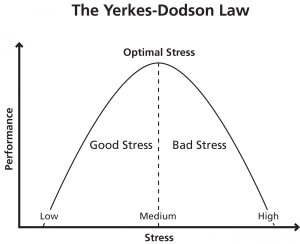“If you wait until the last minute, it only takes a minute to do.” -Stock-Sanford Corollary to Parkinson’s Law
You plan projects ever so carefully, but your projects don’t go according to plan. Inevitably, tasks take longer than we allocated and the whole schedule slips. We blame bad estimates or the team not being given enough time, so next time we add big buffers to each task – just to be safe. And then it still doesn’t get done in time. But what if the problem is just the opposite? What if the estimates are just fine, but the way we work within them messes it all up?
Problem: Not Enough Stress
Here’s a counter-intuitive thought: what if all that buffer time you’re adding is making things worse, not better? The problem is inherent in our approach; we ask a developer how long a task will take, they give us their best estimate, and then we double it. Suddenly, the pressure is off. They can relax, maybe pick up that other to-do item that looks more fun/interesting (AKA “cherry picking”), or just look out the window for a while. When there’s no immediate urgency to do the work, one’s natural tendency to procrastinate kicks in.
This situation is caused by two common principles:
- Student Syndrome: based on the common habit of students where they wait until the last moment to do an assignment. In this case, all the buffer they might have had is wasted up front, leaving them in a stressful “do-or-die” situation. Better schedule that deadline for a Monday so they can get it done on the weekend!
- Parkinson’s Law: the idea that “work expands so as to fill the time available for its completion.” In other words, if you have two weeks to do something, you’ll find a way to use the full two weeks. The best case scenario here is unnecessary over-delivery (AKA “gold plating”). Usually it just means you’re blowing the budget.
Either way, you’ve wasted all that contingency time and introduced a new set of side effects to boot. Not good. So what’s the alternative?
Finding the Sweet Spot of Stress
Quite simply, we need to add some pressure back into the schedule. Not too much, of course (more on that later); we’re looking for that sweet spot between boredom and freaking out that the dynamic duo of Robert Yerkes and John Dodson illustrated in graph form way back in 1908:

This is the good form of stress that gets you out of bed and pushes you to get things done and improve. At the top of the curve, we find a phenomenon known as “flow,” detailed by Czech psychologist Mihaly Csikszentmihalyi in his book of the same name. This is where people get fully immersed in their work, lose all track of time, and achieve remarkable results. Even if you don’t hit the flow state, other benefits of finding that nice middle zone include:
- Heightened alertness and focus
- Better creativity and problem solving
- Increased efficiency and productivity
- Improved memory
That all sounds great – now how do we as PMs help our teams get there?
Critical Chain Project Management
In his book entitled Critical Chain, author Eliyahu Goldratt proposed a shift in how we estimate and schedule tasks. In a nutshell, he suggests that we strip out the contingency time at the task level and then move the cumulative savings to a single buffer at the end of the project. (There’s more to it than that, but that’s the gist of it.) This tightens up the schedule and creates some urgency around each individual task.
Contrary to how it might feel at first blush, this can actually help reduce overall stress. Remember – we’re not asking people to do tasks in less time than is reasonable; we’re just removing the padding. And if a particular task legitimately needs more time than assigned, it dips into the project buffer without impacting the launch date.
This strategy particularly benefits team members who are susceptible to Student Syndrome by helping them to pace themselves through smaller tasks rather than letting work pile up. Think of it as time management coaching.
All this said, there’s still a danger of dancing too close to the line and pushing your team members over to the right half of the curve.
Avoiding Bad Stress
If our more aggressive schedule introduces too much pressure, people can easily end up in that bad stress area. And once they’re over there, all kinds of bad things can happen to them: headaches, sleep problems, irritability, anxiety, etc., etc. With prolonged exposure, it can lead to things as serious as depression and heart disease.
Even if you’re a PM robot and have no empathy whatsoever, you’ll want to avoid stressing out your team because it’s going to hurt your project. Consider these outcomes:
- Lower efficiency and productivity
- Poorer quality work (more mistakes and bugs)
- Impaired judgement and decision-making
- Dampened creativity
- Team burnout and/or turnover
Either way, it’s something that is our responsibility to watch for and avoid. This can be tricky because everyone is different and will react to stress in their own ways. Still, there are some general things we as PMs can do to help.
Stress Strategies for PMs
The good news is that your job description for managing your team’s stress levels are much the same as for just being a good project manager. The list includes:
- Communicate frequently and openly
- Be clear about the big picture and the value of each task within it
- Be organized
- Ensure reasonable resourcing, including workloads on other projects
- Break down tasks into manageable chunks (AKA work breakdown)
- Assign tasks to the right people (with the right skills)
- Provide clear prioritization
- Provide your team with what they need (answers/information/assets)
- Clear away any barriers to the team doing their work
- Manage risk effectively to limit surprises
But you were going to do that anyway, right? If anything from this list wasn’t already on your radar, definitely consider adding it. It’ll help keep your team in the optimal zone – and make you a better all-around PM.
Summary
Managing your team’s stress is a balancing act. Find the sweet spot through aggressive, but not unreasonable timelines and you’ll be amazed at the results. Go too far and you’ll do much more damage than good. Hopefully the information and ideas in this article will help you get the most out of your team while keeping them healthy and happy.

Good read! Thanks for sharing, I will apply this on my projects